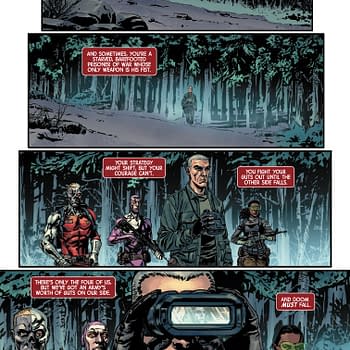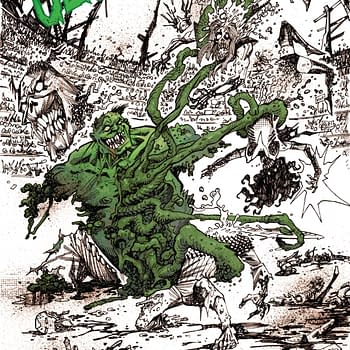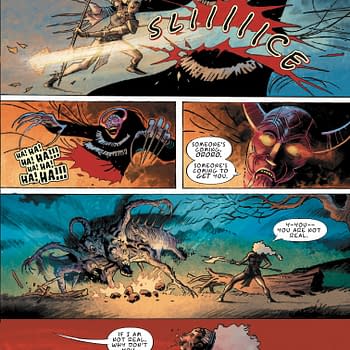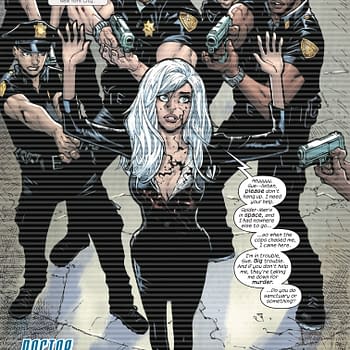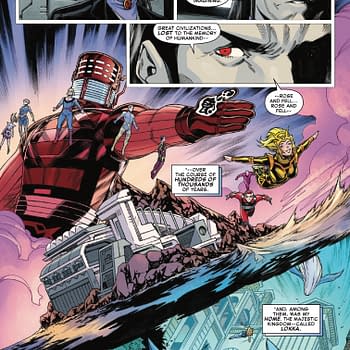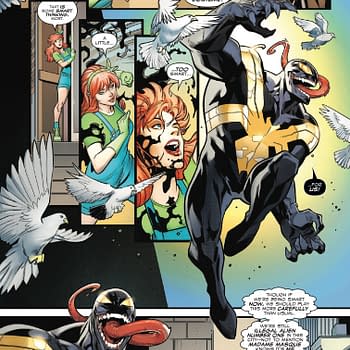Posted in: Comics, Recent Updates | Tagged: dynamite, legendary, Mark Morales, mark waid, Red Circle Comics, shane davis, The Fox, The Green Hornet
Mark Waid Talks To Bleeding Cool About His Upcoming Legendary Book Shadow Walk

Shadow Walk is still maintaining something of an aura of mystery for fans, though a 12 page preview appeared at New York Comic Con and its release date, November 27th, is rapidly approaching. With both Waid and Max Brooks writing, Shane Davis as artist, and Mark Morales as colorist, the series features a very real Valley of Death near modern day Iraq that has scientists and theologians puzzled. It's time to break out your Bibles and brace yourself for a collision with science fiction, and maybe even a little horror, as teams of investigators face the big questions of what lies beyond life and death.
Legendary provides the following synopsis:
"I Walk Through The Valley Of The Shadow of Death…"
Is the Valley of the Shadow of Death a metaphor or could it actually be a real place? Three separate paranormal incidents over the last century, in a valley near modern day Iraq, seem to give credence to these claims. When satellite photos taken over the area hint at a dangerous new energy source, the U.S. decides to send in a Spec-Ops team to locate and extract it before it can fall into enemy hands.
Led by John Raines, a deadly soldier who has been left to rot in Guantanamo, accused of allegedly killing his entire platoon after entering the very same valley years prior, the team heads into dangerous territory to battle demonic creatures with little chance of survival. Armed with two arcane artifacts as their guide and protector, they will find out if the road to Hell just opened up on Earth.
Mark Waid spoke to Bleeding Cool this week about the soon to be released series and what motivates him as a writer.

Mark Waid: It was the idea, the way the basic idea was pitched to me, which is that scientists are faced with this newfound place on earth that shouldn't exist. It was Aliens meets Indiana Jones and I thought, "Well, that's kind of cool". My girlfriend is getting her doctorate in Anthropology so I had a built-in resource there in terms of world history and world culture. I love scientists, nothing I like more. We sat down and we talked about the story, and when I heard the basic pitch, I was in. I liked the gravitas of it. I like the tone that Thomas Tull wanted to approach. And any time I can dive into the Bible for inspiration–and that's speaking as a man who is fairly agnostic without a lot of personal spirituality–I still enjoy diving into the Bible as a book.
HMS: Looking at your recent work with Green Hornet and The Fox, then looking at this book, I'm wondering what types of characters do you find most compelling, as a reader, as a writer. What makes you want to write about them?
MW: That's a very good question. After years and years of writing some of the DC characters like Superman and Batman, and the Legion, these are characters who are not necessarily people with feet of clay. I tend to idolize those characters. They are like unto gods for me. I find it really interesting now to be able to break away and write characters with feet of clay, with flaws, the deeper the better. They are still heroic, but not necessarily admirable. I was writing the Green Hornet as sort of an anti-hero and I can't really point to single characters in Shadow Walk. While they are all interesting and sympathetic characters, I can't really point to anyone there I would like to sit down and have a long conversation with.

MW: Yeah, and really wrestling over the big questions. What is faith? What is the nature of faith? What is the nature of spirituality? What lies beyond us? Is there anything lying beyond us? These are the big questions we wrestle with as adults and I love approaching them in fiction.
HMS: As a reader, I'm really happy that you're exploring these more flawed and complicated characters. In Green Hornet, I really did not expect to be taken there! That was really a psychological book and it picked out human motivations.
MW: Yes, he's a dick! That's the thing. Citizen Kane is my favorite movie. And I find Kane just the most compelling, interesting, layered character in all of film history. Yet, what a jerk! So, the trick is knowing how to get inside that skin, and exploring not just that the character is a jerk, but why he's a jerk. Or in the case of Shadow Walk, why some of these characters may rub against me the wrong way. What it is about them that drives them, even if it's not an emotion or a personal need that I can identify with. I still have to understand it.
HMS: Looking at The Fox, and also at Green Hornet, I'd say you are actually known for your dialogue. I don't know if you're aware of that…
MW: No, I wasn't sure I was aware of that.

MW: That's unique to graphic novels, to tell you the truth. Unique to the comics form. Because in other media you can have them ramble on. With comics, it's a very abbreviated form of storytelling where every word is precious and real estate on the page is critical, so you have to keep those speeches down to a bare minimum. Shave them down to their essence. And the trick there is to shave them down to their essence without hitting it on the nose. Without simply making them people telling you to your face why they act the way they act. So it is a balancing act.
I really just find that the most expedient and the smartest way to do it is to always pretend that these characters are doing something else. I really don't want one of the characters in Shadow Walk walking up and saying, "This is why I feel the way I do about spirituality". Just show me through action and dialogue the kind of person he is and the way he reacts to the other characters around him. Create conflict within your group. And that is, actually, why we put together a group of scientists for this story, scientists and theologians, because I really wanted their views on God and faith, and that creates internal friction. And that immediately gives you something to play off of. That sparks dialogue as opposed to a running, interior monologue in every caption where somebody explains to you how he thinks, which is dull.
HMS: I think that's useful for readers who write to hear you describe that. New creators. Because dialogue is tough. If it's bad, it's really glaring on the page.
MW: And if it's not succinct, it'll just bore. I mean, how many times have you opened up a comic and you're immediately faced with 700 words of dialogue or text? It's not inviting.
HMS: Especially in a first issue, that can be really tough.
MW: And it's not how you use the form. Obviously, there are exceptions to it. But as a general rule, it's a visual medium, so don't imbalance it that way.

MW: Yes, it makes me work even harder as a writer, I've got to tell you. Because nothing will motivate you every month more than getting that thing from Diamond that I call the Necronomicon, that they call the Previews catalogue. And have to slog through that like a husky sled through the arctic. It makes you stunningly aware as a creator how much material you are competing with, whether it sucks or not. Just the sheer volume of it makes you extra self-conscious about the signal to noise ratio in comics. And in my case, I try to use that as a motivation to work even harder. Let's see if it shows.
HMS: I can definitely relate to that because for the past few months I've been doing a live column from a comic shop and I can't believe how many new titles come out every week. You just can't stay on top of them. It's too much.
MW: Like Zenescope comics. Who's buying these? I'm sure the people doing them are awesome, are great, but the covers are like they are for people who don't realize yet that the internet is for porn.
HMS: Well, for me the realization is just how many new titles have come out from Image and from Dark Horse in the past few months. Huge amounts. It's hard to keep a grip on what's happening in comics right now, there's so much.
MW: I know. What's awesome about that is that we are no longer ruled by the Big Two. My store sells more Image Comics than DC comics. And that's not on purpose, that's just the way it falls. That opens readers up to more things than spandex and capes and cowls. And that gives us a platform, not just my store but other stores, to sell some of the other stuff, like what Legendary is selling. And that's one of the things I like about working with them.
I'd like to say this especially to Bleeding Cool–Hi Rich! The thing I'm proudest of and the thing that made me want to work with Legendary is that the moment I sat down and started working on this, the number one creative edict from Thomas Tull and from on high was, "This is not a video game disguised as a graphic novel. This is not a film treatment disguised as a miniseries. This is a graphic novel and the reason we are hiring you is because we know how to do video games and we know how to do films, but we do not know how to do graphic novels. And it is a unique form. Tell the story with integrity". And I loved that approach. I have walked away from a lot of jobs where that has not been the marching orders, but in this case, the story rises and falls on its own merits, and not on whether it would make an awesome Netflix miniseries.
HMS: I wouldn't necessarily associate you with doing something that has horror elements in it, and it sounds like Shadow Walk might. Have you been a reader of horror and historical stuff before?
MW: Not hugely. Not any more than most people who make their livings in borderline science fiction or speculative fiction or than anybody who is a genre reader. But it appeals to me. The thing is, I wouldn't be interested in writing a horror novel or a graphic novel. What I am interested in doing is the friction between science and reality, hope, faith, and religion, against the horror background. It's the friction that interests me.
HMS: Thanks for talking with us, Mark. And best of luck with your comic shop Alter Ego Comics!
Photo courtesy of Seth Kushner
Hannah Means-Shannon is Senior New York Correspondent at Bleeding Cool, writes and blogs about comics for TRIP CITY and Sequart.org, and is currently working on books about Neil Gaiman and Alan Moore for Sequart. She is @hannahmenzies on Twitter and hannahmenziesblog on WordPress. Find her bio here.











